| Previous :: Next Topic |
| Author |
Message |
KarlK
Member


Joined: 18 Jun 2009
Posts: 584 | TRs | Pics
|
 |
KarlK
Member
|
 Thu Nov 10, 2022 9:37 am |
|
|
Hey I'm seeing thoughtful responses on the strength from some of my favorite NW Hikers types. This prompts me to mention one of the reasons I like trail and saw work so much: I get to work with very smart and interesting people and I get to learn a lot by doing so.
I've found the same to be true in the wildland firefighting realm, and very true as well in working with Team Rubicon in disaster responses and mitigation ops. TR is a vetran's led 501c(3) comprised mostly of military vets, former / current first responders, and regular civvies. TR provided me the path to get into WLFF and provided first rate chainsaw training as well. And a bunch of new friends.
Highly recommend checking out Team Rubicon.
https://teamrubiconusa.org/
Karl J Kaiyala
 Brushbuffalo Brushbuffalo
Karl J Kaiyala
 Brushbuffalo Brushbuffalo
|
| Back to top |
  
|
 |
KarlK
Member


Joined: 18 Jun 2009
Posts: 584 | TRs | Pics
|
 |
KarlK
Member
|
 Thu Nov 10, 2022 9:46 am |
|
|
One last clarification made in relation to Sculpin's comment: the shallow arch would add strength to downward force if the ends were pinned, otherwise the load vectors get, in the words of we retired physiologists, "wonky".
|
| Back to top |
  
|
 |
Bowregard
Member


Joined: 05 Feb 2019
Posts: 562 | TRs | Pics
Location: Sammamish |
Thanks for the specs KarlK. That will make interesting reading over the Winter.
There was a question asked earlier by fourteen410 that I think got lost in the Design discussion:
| fourteen410 wrote: | | Thank you! I'm curious - how do you determine what makes a good donor tree for a log bridge, other than length/height? |
I don't know but would guess that species, straightness, lack of very large knots, and grain direction (not spiraled) would play into it. Fir is one of the strongest species around here and I have seen some huge Cedar log bridges (Cedar is not as strong but resists decay well especially very large logs because they have more heartwood).
Can anybody speak with real knowledge on the subject?
|
| Back to top |
  
|
 |
Now I Fly
Member

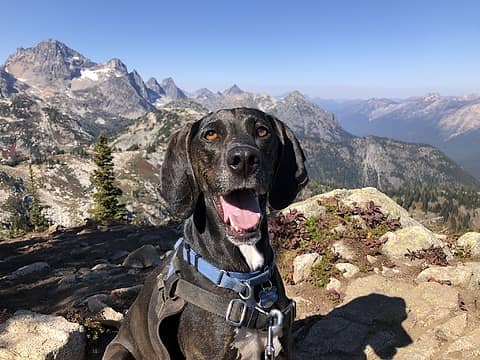
Joined: 07 Jun 2018
Posts: 465 | TRs | Pics
|
Thank you for the great work, and for posting this report! Well done!
|
| Back to top |
  
|
 |
neek
Member


Joined: 12 Sep 2011
Posts: 2337 | TRs | Pics
Location: Seattle, WA |
 |
neek
Member
|
 Thu Nov 10, 2022 10:55 am |
|
|
In addition to being both cool and useful, this could save lives. Well done. Can't wait to check it out.
|
| Back to top |
  
|
 |
Carbonj
Member


Joined: 12 May 2020
Posts: 56 | TRs | Pics
|
 |
Carbonj
Member
|
 Thu Nov 10, 2022 12:02 pm |
|
|
I worked on trail crew for almost 35 years. Yellow cedar,red cedar, and doug fir in that order,were desired for rot resistance and longevity. We would generally use whats nearby on the ground, unless we flew it in, which can be a huge paperwork hassle. True firs and hemlock have a short life span. Putting in footlogs in glacier river you take what you can, but red cedar is the lightest, and when you have 50-60 ft crossings and no standing trees around for rigging light is right, also on the carbon, mowich, and west fork of the white river you can get multiple washouts in a season. One summer we replaced the south mowich 9 times. Also when the log has a curve you place it with the curve down. When a new crew placed a bridge with a pronounced curve up in we took to calling it the hobbit bridge and took bets to how long it would stay upright.
 Bowregard Bowregard
 Bowregard Bowregard |
| Back to top |
  
|
 |
Stefan
Member


Joined: 17 Dec 2001
Posts: 5091 | TRs | Pics
|
 |
Stefan
Member
|
 Thu Nov 10, 2022 4:35 pm |
|
|
I feel like I am watching a bridge builders geek club now.
Art is an adventure.
 Alden Ryno Alden Ryno
Art is an adventure.
 Alden Ryno Alden Ryno
|
| Back to top |
  
|
 |
Sculpin
Member


Joined: 23 Apr 2015
Posts: 1384 | TRs | Pics
|
 |
Sculpin
Member
|
 Fri Nov 11, 2022 9:15 am |
|
|
| KarlK wrote: | | the shallow arch would add strength to downward force if the ends were pinned, otherwise the load vectors get, in the words of we retired physiologists, "wonky". |
Sorry, this triggered more geekiness.  The word "strength" is confusing here. An arched shape reduces downward deflection in the middle compared to a log of the same diameter that is straight. As to the load distribution, it is easy to calculate when the ends are pinned* but would require finite element analysis of the log to estimate when they are not pinned. You cannot do finite analysis on a log cut in the backcountry, hence there is no way to calculate how much reduction in deflection occurs. This means that you cannot use the arch in your calculation. But it still reduces downward deflection!
This is a problem in engineering statics (even though the person is walking across, the point load when the person is exactly in the middle is the quantity of interest). Doesn't Eric Gilbertson teach statics?
*Highway bridges that predate the computer era were generally pinned at the joints, you can easily see the pins when you drive by. The pinning does not make the bridge stronger, but the pins can flex slightly to adjust for load variations. The key point is that the engineer who designed the bridge was able to estimate the load at each joint. If they were welded joints there was no practical way to calculate the load distribution without finite element analysis which was not possible by hand. Not sure how many of these bridges still remain.
The word "strength" is confusing here. An arched shape reduces downward deflection in the middle compared to a log of the same diameter that is straight. As to the load distribution, it is easy to calculate when the ends are pinned* but would require finite element analysis of the log to estimate when they are not pinned. You cannot do finite analysis on a log cut in the backcountry, hence there is no way to calculate how much reduction in deflection occurs. This means that you cannot use the arch in your calculation. But it still reduces downward deflection!
This is a problem in engineering statics (even though the person is walking across, the point load when the person is exactly in the middle is the quantity of interest). Doesn't Eric Gilbertson teach statics?
*Highway bridges that predate the computer era were generally pinned at the joints, you can easily see the pins when you drive by. The pinning does not make the bridge stronger, but the pins can flex slightly to adjust for load variations. The key point is that the engineer who designed the bridge was able to estimate the load at each joint. If they were welded joints there was no practical way to calculate the load distribution without finite element analysis which was not possible by hand. Not sure how many of these bridges still remain.
Between every two pines is a doorway to the new world. - John Muir
 Brushbuffalo Brushbuffalo
Between every two pines is a doorway to the new world. - John Muir
 Brushbuffalo Brushbuffalo
|
| Back to top |
  
|
 |
Kim Brown
Member


Joined: 13 Jul 2009
Posts: 6899 | TRs | Pics
|
| Carbonj wrote: | | Also when the log has a curve you place it with the curve down. When a new crew placed a bridge with a pronounced curve up in we took to calling it the hobbit bridge and took bets to how long it would stay upright. |
I think that's more about how it was anchored, rather than an upward arch not offering better support; is that correct? Seems if it were placed with the arch up, but not anchored with enough "ooomph," it would eventually twirl so the arch would be upside down.
"..living on the east side of the Sierra world be ideal - except for harsher winters and the chance of apocalyptic fires burning the whole area."
Bosterson, NWHiker's marketing expert
"..living on the east side of the Sierra world be ideal - except for harsher winters and the chance of apocalyptic fires burning the whole area."
Bosterson, NWHiker's marketing expert
|
| Back to top |
  
|
 |
Kim Brown
Member


Joined: 13 Jul 2009
Posts: 6899 | TRs | Pics
|
Loving the discussion here. Most is over my head, but I like it anyway. If I could do it all over again I'd be either a musician or an engineer. Or an eccentric rich person.
But all I know about engineering is what I see on Bugs Bunny cartoons.
In my right-brained mind, seems that if a load were at the top of the arch, the weight is distributed to each side of the arch; once the energy meets resistance at each end, it stacks up and creates a stronger support overall. The arch itself is the distributor of energy.
Am I correct? (Seems that's about what KarlK says, with perhaps some added cartoonic nonsense)
"..living on the east side of the Sierra world be ideal - except for harsher winters and the chance of apocalyptic fires burning the whole area."
Bosterson, NWHiker's marketing expert
 Brushbuffalo Brushbuffalo
"..living on the east side of the Sierra world be ideal - except for harsher winters and the chance of apocalyptic fires burning the whole area."
Bosterson, NWHiker's marketing expert
 Brushbuffalo Brushbuffalo
|
| Back to top |
  
|
 |
KarlK
Member


Joined: 18 Jun 2009
Posts: 584 | TRs | Pics
|
 |
KarlK
Member
|
 Fri Nov 11, 2022 9:45 am |
|
|
In reply to fourteen410's question about what makes a good donor tree here's how this worked:
The Other Mike and Joe Hofbeck (both retired engineers with abundant backcountry bridge-building experience) evaluated options that were pragmatically close to the bridge site in 2021. A nice spec-worthy Doug fir was identified on the N side of Eureka Creek (healty, sufficient diameter and length). Landon Decker (MVRD Trails Manager) OK'd the selection, and he and one of his crew members expertly felled the tree on Oct 12, 2021, dropping it between two potentially tree-busting rock features to prevent breakage.
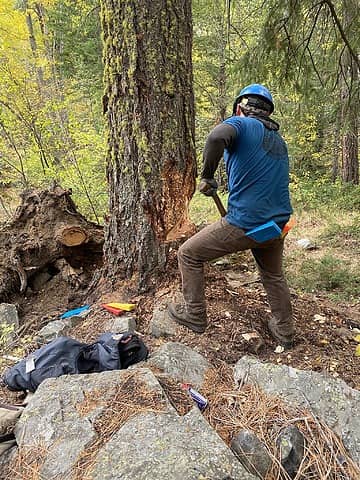 Landon chopping the face cut  Landon and Collin sawing the backcut 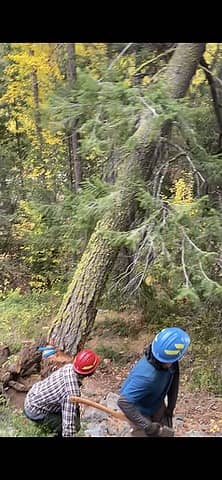 There it goes! 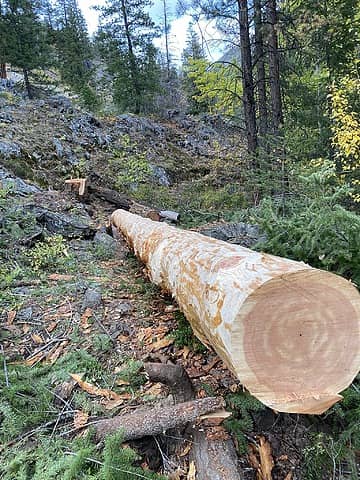 Peeled -- A teriffic log! Note placement between rocks
|
| Back to top |
  
|
 |
Brushbuffalo
Member


Joined: 17 Sep 2015
Posts: 1887 | TRs | Pics
Location: there earlier, here now, somewhere later... Bellingham in between |
Karl, two minor questions not yet brought into this fascinating thread: 1)how many ripping chains did you go through on your big Stihl? 2)Did one of you locate some blocks of ABS and manufacture the shims to fit?
Fantastic project. I may never get back there again, but many future wilderness wanderers will have much easier and safer access to a rough and scenic area, thanks to your collective dedication and sweat.
Passing rocks and trees like they were standing still
Passing rocks and trees like they were standing still
|
| Back to top |
  
|
 |
KarlK
Member


Joined: 18 Jun 2009
Posts: 584 | TRs | Pics
|
 |
KarlK
Member
|
 Fri Nov 11, 2022 10:34 am |
|
|
Brushbuffalo -- The Other Mike did the chainsaw milling with his 460 and did not indicate the number of ripping chains involved. But me did mention that the job wore out the guide bar groove. 32 inch guide bars are pricey!
Mike also indicated that the hardware he donated to the project equated to $300 of out-of-pocket expenses.
As you know (perhaps all too well) volunteers often spend a lot of $$$. I think that one of the reasons trail vols tend to be older folks is that we old guys and gals have all the money!
Joe H and Steve G made the ABS shims.
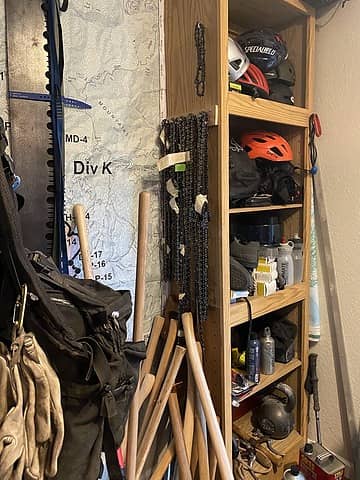 Chainsaw chains in various states of health
|
| Back to top |
  
|
 |
KarlK
Member


Joined: 18 Jun 2009
Posts: 584 | TRs | Pics
|
 |
KarlK
Member
|
 Fri Nov 11, 2022 1:00 pm |
|
|
Dear Sculpin --
Yep, I had a convo with Joe H the morning and he said what you said.
All readers of this discussion are now eligible for the Joe and Karl Certificate of Backcountry Bridge Engineering. It's delivered free, in imaginary form, and has a tasteful imaginary gold trim. Possession of the JAKCBBE makes the possessee eligible to help with trail and bridge projects. 
|
| Back to top |
  
|
 |
Sculpin
Member


Joined: 23 Apr 2015
Posts: 1384 | TRs | Pics
|
 |
Sculpin
Member
|
 Fri Nov 11, 2022 5:28 pm |
|
|
| Kim Brown wrote: | | seems that if a load were at the top of the arch, the weight is distributed to each side of the arch; once the energy meets resistance at each end, it stacks up and creates a stronger support overall. The arch itself is the distributor of energy. |
That's it!  A loaded spanning beam will always have regions in tension and regions in compression, so there is complexity there, but your words indicate that you intuitively understand what is happening.
Thanks for the swell certificate, KarlK! I may well cash it in.
A loaded spanning beam will always have regions in tension and regions in compression, so there is complexity there, but your words indicate that you intuitively understand what is happening.
Thanks for the swell certificate, KarlK! I may well cash it in.
Between every two pines is a doorway to the new world. - John Muir
Between every two pines is a doorway to the new world. - John Muir
|
| Back to top |
  
|
 |
|
|